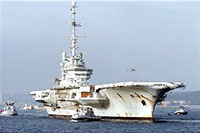Mighty French Warship Ends Its Days
by Jamey Keaten, The Washington Post (Associated Press)
 |
 |
 |
 |
| |
 |
|
| |
The former French aircraft carrier Clemenceau is towed from the military harbour of Toulon, southern France, in this Dec. 31, 2005 file photo. France's Defense Minister Michele Alliot-Marie announced Tuesday Feb.14, 2006 that she had ordered an investigation into how many tons of asbestos remain on the warship being sent to India for dismantling. © AP Photo/Claude Paris |
|
 |
 |
 |
|
| |
15 February 2006 (Paris) –
When it first took to the seas nearly 50 years ago, the Clemenceau was the crown jewel of French naval prowess. Today, the decommissioned aircraft carrier is an albatross for France amid an uproar over the toxic waste the hulking ship carries.
The saga underlines the trouble many countries face in getting rid of retired vessels. It has also become an embarrassment for the French Defense Ministry, which environmentalists criticize for not addressing the potential risks of sending the ship to India for dismantling.
The Clemenceau _ now known as the Q 790 _ first set sail in 1957. Taken out of service in 1997, it is now in the Arabian Sea, having left the French Mediterranean port of Toulon on Dec. 31. Egypt kept the ship from crossing the Suez Canal for more than a week last month before officials there ruled it would not harm the environment.
It's expected to reach a shipbreaking yard in western India early next month, though the ship's journey has been stalled as French and Indian courts seek to determine how much asbestos is on board and the risks to workers taking it apart.
French officials have said there are 45 tons of asbestos on the ship, but environmentalists put that number at up to 1,000 tons.
Environmentalists insist the Clemenceau should have been cleaned up before leaving port and say France's transfer of the vessel violates the Basel Convention, an international accord on trade in potentially hazardous waste.
On Tuesday, President Jacques Chirac's spokesman announced that the French leader was personally handling the Clemenceau issue, just days before leaving for a visit to India. The spokesman did not explain why Chirac was intervening, but it was a measure of France's discomfort that he felt the need to get involved.
French Defense Minister Michele Alliot-Marie said France had few options other than sending the ship to India.
"There's no solution for dismantling thousands of warships now rusting in certain places in the world, which is extremely harmful to the environment," she said Tuesday on Europe-1 radio. "There are no dismantling yards in Europe; none in the United States."
Capt. Lawrence M. Jones, who runs the U.S. Navy's Inactive Ships Program, corrected her in an Associated Press phone interview, saying his program uses three scrapping yards in the United States.
Environmentalists bristled at her comments.
"If Michele Alliot-Marie believes there are no dismantling sites (in France), then she should build some," Pascal Husting, director of Greenpeace France, told the AP.
Merchant marine ships far outnumber naval vessels awaiting attention in junk heaps, and the need is only going to grow: The French Defense Ministry says about 700 vessels worldwide are taken apart each year, and that figure is likely to double in two to three years.
Governments do have options with retired boats. France has parked some outside ports in the western city of Brest or southern Toulon as wave-breakers; some are sold secondhand.
The United States made a splash in 2005 by using the USS America for explosion tests before it sank. The U.S. Navy also donates some ships, and has begun a program to foster reef growth, Jones said. The Navy has 54 ships lined up for disposal, he said.
Sending ships for a date with the wrecking ball is rarely popular, and courts often intervene. Some of the vessels carry asbestos, freon, mercury, cancer-causing polychlorinated biphenyls _ PCBs _ or other toxins.
When the Clemenceau was built, asbestos wasn't widely known to be a health hazard.
"Many ships that have been built before a certain date have this asbestos problem," said Jurrien Noot, a naval construction analyst at Jane's Information Group. "You might say this was a time bomb waiting to go off."
The Clemenceau, which is far smaller than most U.S. aircraft carriers, was a core ship in French naval operations for nearly 40 years. It traveled the equivalent of 50 times around the world, and more than 20,000 naval crew members served on its decks.
Associated Press Writer Paul Duke in Paris and Nirmala George in New Delhi contributed to this report.
FAIR USE NOTICE. This document contains copyrighted material whose use has not been specifically authorized by the copyright owner. The Basel Action Network is making this article available in our efforts to advance understanding of ecological sustainability and environmental justice issues. We believe that this constitutes a 'fair use' of the copyrighted material as provided for in section 107 of the US Copyright Law. If you wish to use this copyrighted material for purposes of your own that go beyond 'fair use', you must obtain permission from the copyright owner.
More News
|